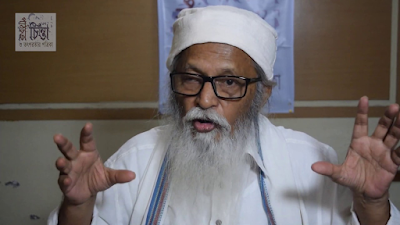I did not know when the police were given responsibility for ensuring singers sing to the proper tune of the song, especially ‘Rabindra Sangeet’ (Tagore Songs).
Tomorrow, they will haul singers singing ‘Nazrul Geeti’ or band (or pop) music for not strictly following the music grammar.
Remember, the police arrested folk singers and send them to prison for singing folk songs, which they said had hurt the feeling of the Muslims.
During the coronavirus pandemic in 2020, two Baul (mystic) singers—Rita Dewan and Shariat Sarker were arrested separately under the repressive Digital Security Act, for allegedly “hurting the religious sentiments of Muslims.”
Social media is flooded with protests and satire posts by academics, journalists, social justice advocates, human rights defenders and of course the netizens.
Police recently harassed a nondescript Youtuber and video-blogger Hero Alom, who was born and lives in Bograand was summoned to the office of the Detective Police.
He was not charged after he signed an apology on a piece of paper stating that he will never sing Tagore Songs in distorted tune and proper pronunciation. It is understood that some aggrieved persons had complained against Alom to the police. Is it a crime to sing inappropriately?
How do the law enforcement officers understand Hero Alom’ssongs on the YouTube channel were distorted? Are they certified by a musical institute or themselves graduates from a music college or an institute – likeChhayanaut, Bangladesh Academy of Fine Arts (BAFA), Government Music College or any recognised music institutions in the country?
If they are not certified music experts, have they consulted with a music connoisseur or teacher of RabindraSangeet? Unfortunately, they have not!
The nation has not forgotten that songs and poetry penned by Rabindranath Tagore were banned from broadcast by the Dhaka station of Radio Pakistan in 1967 during the military junta of General Ayub Khan.
Tagore is considered taboo in Pakistan since the partition in 1947. Finally, all works of Tagore were officially banned in government media (Radio Pakistan, PTV, government-owned newspapers) by the orders of powerful information and broadcasting ministerKhwajaShahabuddin and vetted by East Pakistan governor Monem Khan in 1967.
One reason is that he is an Indian. Secondly, he was dubbed as a Hindu – which fortunately he was not. His family practised Brahmmo – believing in One God, singing the Upanishad’s ‘ekeshwar’ and distanced themselves from idolatry. His father, Debendranath Tagore, adopted the Brahmofaith and does away with the rituals of Sanatan Dharma (faith).
Rabindranath Tagore is a poet of Bengal, India, and the world. Songs of Nobel laureate Rabindranath are national anthems in India, Bangladesh and Sri Lanka and of course,in the minds and hearts of the Bangalee diaspora (from both sides of Bengal) living abroad.
The Islamists in Bangladesh for decades have been demanding of the government to trash the national anthem written by Tagore, who is dubbed a Hindu and an Indian.
Scores of Mullahs in Waz-Mehfil(Islamic rallies) uploaded videos on YouTubethreatening to forcibly change the national anthem, which they explain compromises the culture, language and spirit of majoritarian Sunni Muslims.
Well, the Islamist has not only called to get rid of the national anthem but also dared to speak nonsense against the national flag, and state constitution. They debunkedPahelaBaishak (Bangla New Year), Ekushey February (International Mother’s Language Day) and the rich cultural heritage of Bengal.
They taunt at independence war which created Bangladesh, after a humiliating surrender of marauding Pakistan military at Dhaka on 16th December 1971. They challenge the figures of 3 million victims of genocide and said Muslim soldiers cannot kill Muslims.
In the Waz, they speak foul regarding women’s education, women’s empowerment and women in leadership.
Islamist hate-speech does attack Hindus, Christians, Buddhists and Adivasis. They warn them that the land they are born among the majoritarian Muslims. Even, they provoke the government to ban Ahmadiyya – whom they say are not Muslims.
This does not end here!
The Islamists coerced the authorities to change the school textbooks in Bangladesh. The authority deleted several pieces of literature and poetry written by Hindu litterateurs. Even the sketches in the textbooks have been replaced by girls and women in headcovers and men wearing ‘Tupi’ (cap). The boys in half-pants or shorts have been replaced with pyjama and panjabi.
Well, to conclude the police and civil administration have turned a blind eye to the Waz-Mefils spitting hate-speech against the state authority, the spirit of the liberation war, and the religious and ethnic minorities.
Not to be surprised, none of the Islamic evangelists has been prosecuted under the controversial Digital Security Act, nor faced music of justice.
Is it not true that the draconian cyber law is only used against critics of the government, opposition, journalists, netizens, cultural activists and human rights defenders and not the Islamist hate-speech mongers?
First published in The News Times, 30 July 2022
Saleem Samad, is an independent journalist, media rights defender, recipient of Ashoka Fellowship and Hellman-Hammett Award. He can be reached at: saleemsamad@hotmail.com; Twitter @saleemsamad


